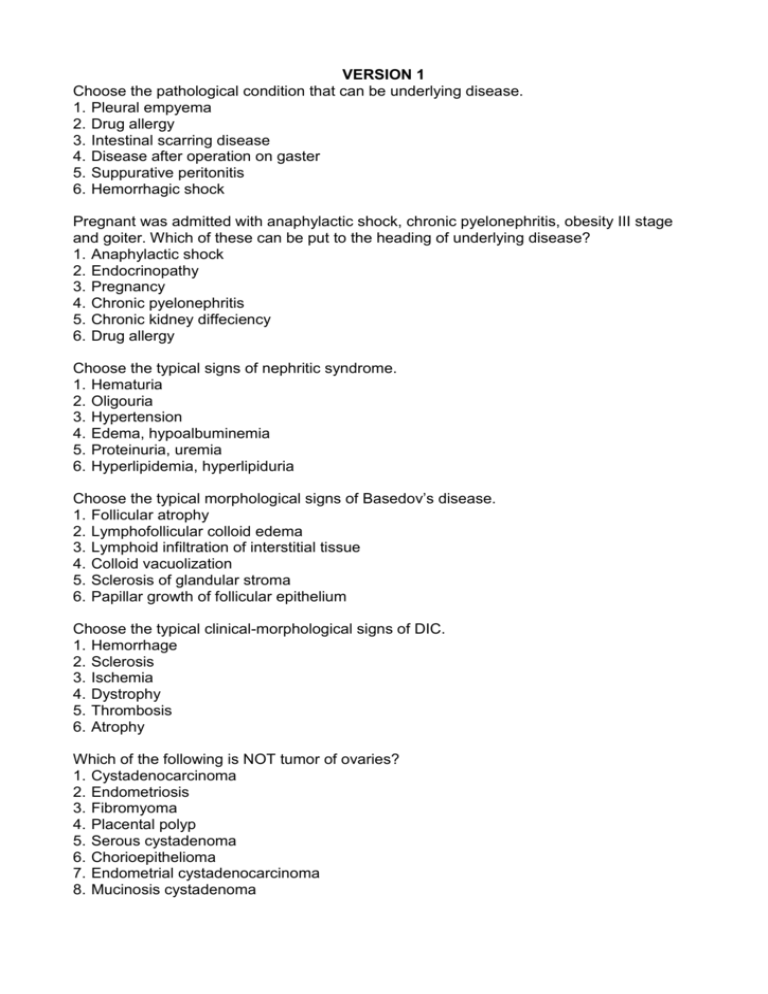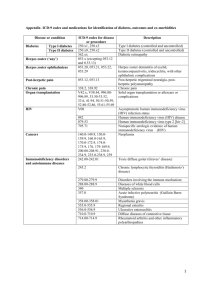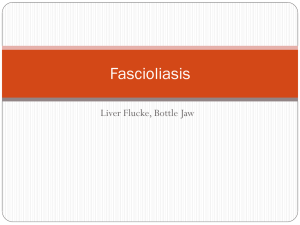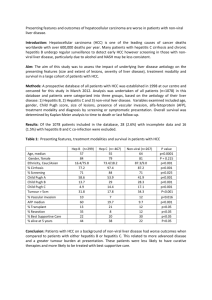Version 1 Choose the pathological condition that can be underlying
advertisement

VERSION 1 Choose the pathological condition that can be underlying disease. 1. Pleural empyema 2. Drug allergy 3. Intestinal scarring disease 4. Disease after operation on gaster 5. Suppurative peritonitis 6. Hemorrhagic shock Pregnant was admitted with anaphylactic shock, chronic pyelonephritis, obesity III stage and goiter. Which of these can be put to the heading of underlying disease? 1. Anaphylactic shock 2. Endocrinopathy 3. Pregnancy 4. Chronic pyelonephritis 5. Chronic kidney diffeciency 6. Drug allergy Choose the typical signs of nephritic syndrome. 1. Hematuria 2. Oligouria 3. Hypertension 4. Edema, hypoalbuminemia 5. Proteinuria, uremia 6. Hyperlipidemia, hyperlipiduria Choose the typical morphological signs of Basedov’s disease. 1. Follicular atrophy 2. Lymphofollicular colloid edema 3. Lymphoid infiltration of interstitial tissue 4. Colloid vacuolization 5. Sclerosis of glandular stroma 6. Papillar growth of follicular epithelium Choose the typical clinical-morphological signs of DIC. 1. Hemorrhage 2. Sclerosis 3. Ischemia 4. Dystrophy 5. Thrombosis 6. Atrophy Which of the following is NOT tumor of ovaries? 1. Cystadenocarcinoma 2. Endometriosis 3. Fibromyoma 4. Placental polyp 5. Serous cystadenoma 6. Chorioepithelioma 7. Endometrial cystadenocarcinoma 8. Mucinosis cystadenoma Choose the causative agents of viral hepatitis. 1. RNA virus 2. Rickettsia 3. RNA virus with HBsAg 4. DNA virus 5. Unispiral DNA virus 6. Unispiral RNA virus In biopsy material of patient with chronic hepatitis: fibrous foci around central vein and triads, biliary tracts are proliferated, cholestasis. Choose the items that are put into diagnosis. 1. Portal cirrhosis 2. Hepatocellular cancer 3. Biliar cirrhosis 4. Portal hypertension Patient complains of the pain in the right subcostal area that is irradiated to right hand, scapula and back during several days. Nausea, vomiting, fever, leukocytosis were found. On palpation abdominal muscles are tense, tenderness on liver. What is this disease and choose the complications. 1. Acute cholecystitis 2. Bradycardia 3. Appendicitis 4. Liver failure 5. Liver coma 6. Biliar peritonitis 30 year old man was admitted with pain on right subcostal area and vomiting after meal. The signs intensify in spring. They are associated with nausea, belching. Which complications can cause the death? 1. Abscess 2. Perforation 3. Peritonitis 4. Penetration 5. Hemorrhage 6. Stenosis Which are essential in development of Crohn’s disease? 1. Serotype of colon bacillus 2. Enteropathies 3. RNA virus 4. Idiopathic changes on intestinal wall4. Ичак деворидаги идиопатик ўзгаришлар 5. Mycobacteria 6. Hereditary factors VERSION 2 Choose the pathological conditions that can be underlying diseases. 1. Epidemic hepatitis 2. Hemorrhagic pleuritis 3. Lobar pneumonia 4. Fibrillation for ventricles 5. Cardiac tamponade 6. Decompensation of pulmonary heart 7. Glomerulonephritis 8. Gastric ulcer Which of the followings can be the cause of acute pancreatitis? 1. Ulcerative colitis 2. Intoxication 3. Peritonitis 4. Diabetes mellitus 5. Alcoholism 6. Anemia associated with insufficiency of folic acid Which of the followings is associated with hemoglobinuria nephrosis? 1. Hemorrhagic shock, DIC syndrome 2. Malaria 3. Toxic dystrophy of liver 4. Transfusion of incompatible blood Which pathologic process do NOT cause the trophoblastic disease? 1. Endometriosis 2. Dysplastic endometriosis 3. Endometrium polyp 4. Chorionepithelioma 5. Endometrium hyperplasia Which can NOT be the direct cause of death in heart ischemic disease? 1. Cardiosclerosis 2. Fibrillation 3. Focal cardiosclerosis 4. Cardiac tamponade 5. Coronarocardiosclerosis 6. Acute cardiac failure 7. Chronic aneurism 8. Asistolia If essential hypertension is associated with brain hemorrhage, atherosclerosis, nephrosclerosis what is written in the headings Ia, Ib, Ic of death certificate? 1. Brain hemorrhage 2. Rupture of cerebral vessel 3. Essential hypertension, atherosclerosis 4. Atherosclerosis 5. Nephrosclerosis 6. Essential hypertension Choose the microscopic changes in liver with acute viral hepatitis. 1. Absence of hepatocytes regeneration 2. Corpuscles of Kaunsilman 3. Lipid dystrophy of hepatocytes 4. Lymphoid infiltration 5. Absence of hyperplasia of Kupfer cells 6. Coagulation necrosis In deceases because of alcoholism - liver is yellow, nodular, fatty, wrinkled. Choose the right cause of death. 1. Liver failure 2. Acute hepatitis 3. Posthemorrhagic anemia 4. Cholecystitis 5. Pancreatitis 6. Bleeding from esophagus Where do the cholecyst cancer give metastasis? 1. Bones 2. Portal lymphatic nodes 3. Mesenteric lymphatic nodes 4. Liver 5. Lungs 6. Ovaries Which of the following is essential in development of duodenal ulcer. 1. Antral chronic gastritis 2. Acute hepatitis 3. Increase in acid concentration 4. Atrophic chronic gastritis 5. Acute pancreatitis 6. Gastric hypersecretion Which is NOT typical for Crohn’s disease? 1. Sclerosis and dilation of lymphatic vessels 2. Inflammation of mesentery 3. Absence of inflammation of mesentery 4. Absence of infiltration on intestinal wall 5. Suppurative inflammation of ulcer 6. Mononuclear infiltration of intestinal wall 7. Absence of nodules 8. Absence of suppuration of ulcer VERSION 3 Choose the pathological conditions that can be the complications of disease. 1. Hemorrhagic shock 2. Bronchogenic cancer of lung 3. Duodenal ulcerative disease 4. Decompensation of pulmonary heart 5. Hemorrhagic pleuritis 6. Acute phlegmonous appendicitis 7. Epidemic hepatitis 8. Peritonitis Choose the signs that are NOT typical for nephritic syndrome. 1. Edema 2. Hypertrophy of left ventricle 3. Proteinuria 4. Oliguria 5. Hematuria 6. Hyperlipidemia 7. Hypertension Choose the signs that are NOT typical for portal hypertension. 1. Stenosis of upper vena cava 2. Splenomegaly 3. Nutmeg liver 4. Ascites 5. Goose liver 6. Liver encephalopathy 7. Thrombosis lower vena cava 8. Varix dilation of stomach and esophagus Choose the causes functional deficiency of myocardium and intestines in cholera. 1. Hyperkalemia 2. Hypersecretion 3. Hypernatremia 4. Hypovolemia 5. Hypokalemia 6. Disturbance of reabsorption Choose the infections that are NOT typical for AIDS. 1. Cytomegalovirus, herpes 2. Streptococci 3. Blue pus bacillus 4. Candidosis, toxoplasmosis 5. Pneumocystosis, mycobacteria 6. Staphylococci If there are aorta atherosclerosis, chronic bronchitis, emphysema, chronic Glomerulonephritis, hypertension, brain hemorrhage, which of them can be underlying disease and complications? 1. Chronic glomerulonephritis 2. Emphysema 3. Brain hemorrhage 4. Aorta atherosclerosis 5. Chronic bronchitis 6. Hypertension Which may identified in chronic persisted hepatitis? 1. Transformation to cirrhosis 2. Infiltration with lymphocytes, macrophages, plasmocytes of liver pieces 3. Diffuse necrosis of hepatocytes 4. Presence of HBc antibodies for 2 years Patient with cholecystitis for a long period complained of fever, leukocytosis, pain in right subcostal area, jaundice (+++), enlargement of liver and lien. What processes developed in disease? 1. Primary biliary cirrhosis 2. Secondary biliary cirrhosis Choose the primary cancers of liver. 1. 2. 3. 4. 5. 6. Hepatocellular cancer Diffuse cancer Combined cancer Squamous cell cancer Metastatic cancer Cholangiocellular cancer Which is essential in development of acute ulcers of stomach? 1. Chronic pancreatitis 2. Burn 3. Trauma 4. Chronic duodenitis 5. Pernicious anemia 6. Stress 7. Chronic enteritis 8. Shock With which diseases is Crohn’s disease differentially diagnosed? 1. Acute appendicitis 2. Peritonitis 3. Acute enteritis 4. Extrauterine pregnancy VERSION 4 Choose the pathological conditions that can NOT be concomitant disease. 1. Hemorrhagic shock 2. Chronic bronchitis 3. Gastric cancer 4. Chronic pneumonia 5. Ulcerative disease of stomach 6. Liver cirrhosis 7. Lobar pneumonia 8. Peritonitis Choose the typical signs for nephrotic syndrome. 1. Proteinuria 2. Hypolipidemia 3. Edema 4. Hypertension, hypertrophy of left ventricle 5. Dysalbuminemia 6. Hematuria, oliguria 7. Anuria, uremia 8. Hypoalbuminemia Choose the signs typical for portal hypertension. 1. Ascites 2. Thrombosis of lower vena cava 3. Splenomegaly 4. Goose liver 5. Stenosis of upper vena cava 6. Liver encephalopathy 7. Nutmeg liver 8. Varix dilation of stomach and esophagus Which disease is associated with true croup? 1. Influence, hemorrhagic laryngitis 2. Fibrinous laryngitis 3. Rubella, fibrinous laryngitis 4. Suppurative laryngitis 5. Rubella, catarrhal laryngitis 6. Diphtheria Where is written in the heading of underlying disease with the mistaken diagnosis like rupture of gastric ulcers and diffuse peritonitis when systemic lupus erythematosus, rheumatism, polyartritis are treated with corticosteroids? 1. Polyartritis 2. Rupture of acute gastric ulcers 3. Diffuse peritonitis 4. Systemic lupus erythematosus 5. Rheumatism 6. Iatrogenia What will be in chronic active hepatitis? 1. Absence of fibrosis in liver tissue 2. Bridging necrosis of hepatocytes 3. Infiltration with lymphocytes, macrophages, plasmocytes of portal tracts 4. Phased active destruction of hepatocytes Choose the pathologic processes written in the heading Ia of death certificate. 1. Brain hemorrhage 2. Cause of underlying disease 3. Cardiac tamponade 4. Concomitant disease 5. Peritonitis 6. Background disease 7. Underlying disease 8. Pulmonary edema Patient with cholecystitis for a long period complained of fever, leukocytosis, pain in right subcostal area, jaundice (+++), enlargement of liver and lien. What complications developed in disease? 1. Liver failure 2. Hepatocellular cancer 3. Secondary biliary cirrhosis 4. Portal hypertension 5. Mechanic jaundice 6. Xanthomatosis In liver biopsy there are accumulations of giant cells formed from randomly located polynuclear hepatocytes, stroma is bad developed, vessels are few. Which type of cancer is this? 1. Differentiated adenocarcinoma 2. Hepatocellular cancer 3. Less differentiated cancer 4. Primary adenocarcinoma Autopsy is postmortem examination: 1. Determination of main structural changes 2. Determination of microscopic changes of death cause 3. Determination of death cause and correct filling of death certificate 4. Statement about death factors 5. Finding the death cause 6. Determination of external changes VERSION 5 Choose the pathological condition that can be concomitant disease. 1. Gastric ulcerative disease 2. Lobar pneumonia 3. Chronic bronchitis 4. Peritonitis 5. Hemorrhagic shock 6. Liver cirrhosis 7. Gastric cancer 8. Chronic pneumonia Choose the differential morphologic signs of alcoholic hepatitits. 1. Mallori corpuscle 2. Fatty dystrophy 3. Periportal infiltration 4. Kaunsilman’s corpuscles 5. “Rice” corpuscles 6. Negri’s corpuscles Choose the complications of cholera. 1. Typhoid 2. Erysipelas 3. Exicosis 4. Phlegmon 5. Uremia 6. Abscesses and sepsis When is the syphilitic nodule formed? 1. Visceral syphilis 2. Secondary syphilis 3. Congenital hematogenic syphilis 4. Primary syphilis 5. Hematogenic syphilis 6. Primary and secondary syphilis Where is written in the heading of Ia, Ib, Ic with the mistaken diagnosis like rupture of gastric ulcers and diffuse peritonitis when systemic lupus erythematosus, rheumatism, polyartritis are treated with corticosteroids? 1. Polyarthritis 2. Perforation of acute gastric ulcers 3. Iatrogenia 4. Systemic lupus erythematosis 5. Rheumatism 6. Diffuse peritonitis What are the death causes of alcoholic cirrhosis? 1. Liver failure 2. Hepatomegaly 3. Hepatosplenomegaly 4. Mallory-Weiss syndrome 5. Portal hypertension 6. Bleeding from esophagus What are the main functions of pathologicoanatomical science? 1. Repeated preparation of pathoanatomists 2. Help clinicians to determine the diagnoses of patients 3. Help for doctors’ improvement 4. Timely determination of special danger infections 5. Help forensic medical experts 6. Combine the jobs of pathoanatomists 7. Determination of main direction on work 8. Improvement of pathoanatomists 9. Preparation of pathoanatomists 10. Improvement of treatment and diagnostics 11. Control of doctors 12. Discover new scientific directions on problems of human pathology What are the complications of idiopathic ulcerative colitis? 1. Rectovaginal fistula 2. Intestinal stenosis 3. Peritonitis 4. False polyps 5. Perforation 6. Toxic dilation of rectum Direct cause of death is … . 1. Complex of processes that lead to death 2. Pathologic process that lead to changes incompatible to human life How is the underlying disease written in the headings Ia, Ib, Ic of death certificate? 1. Concomitant disease 2. Complication that lead to direct cause of death 3. Underlying disease 4. One of the complications 5. Background disease 6. Direct cause of death VERSION 6 Choose the pathologic conditions that can NOT be underlying disease. 1. Diffuse peritonitis 2. Gastric ulcerative disease 3. Cardiac tamponade 4. Cirrhotic cancer of liver 5. Lobar pneumonia 6. Epidemic hepatitis 7. Toxic shock 8. Uremia For which liver diseases are Kaunsilman corpuscles typical? 1. Chronic viral hepatitis A 2. Chronic viral hepatitis B 3. Acute viral hepatitis A 4. Acute viral hepatitis B Choose the causes of suprahepatic hypertension. 1. Thrombosis of lower vena cava 2. Liver edema 3. Granulomatosis diseases 4. Stenosis of lower vena cava Choose the foci that are NOT typical for secondary tuberculosis. 1. Abrikosov’s focus 2. Lymphadenitis 3. Lymphangitis 4. Gohn’s focus 5. Simon’s focus 6. Aschoff-Pul’s focus Choose the processes that can NOT be underlying disease. 1. Uterus fibromyoma 2. Uterus bleeding 3. Posthemorrhagic shock 4. Chorioepithelioma 5. Peritonitis 6. Endometriosis 7. Glandular hyperplasia of endometrium 8. Endometritis after delivery Choose the pathologic process that is written in Ib of death certificate. 1. Underlying disease 2. Gastric cancer 3. Concomitant diseases 4. Direct cause of death 5. Glomerulonephritis 6. Background disease 7. Myocardial infarction Choose the types of ischemic necrosis. 1. Bedsore 2. Cerebral infarction 3. Lien infarction 4. Caseous necrosis 5. Gangrene 6. Sequestration 7. Myocardial infarction 8. Kidney infarction In patient with chronic hepatitis it was defined ascites, varix dilation of anterior abdominal wall, splenomegaly. With what is the portal hypertension connected? 1. Chronic pyelonephritis 2. Development of sclerosis in portal tracts 3. Splenomegaly 4. Chronic colitis 5. Chronic active hepatitis 6. Reconstruction of liver tissue Autopsy is postmortem examination: 1. Determination of main structural changes 2. Determination of microscopic changes of death cause 3. Determination of death cause and correct filling of death certificate 4. Statement about death factors 5. Finding the death cause 6. Determination of external changes What is the death cause in nonspecific ulcerative colitis? 1. Intestinal perforation 2. False polyps 3. Bleeding 4. Intestinal cancer 5. Peritonitis 6. Intestinal stenosis Complications of underlying disease - … . 1. Pathologic processes that are etiologically and pathogenetically connected with underlying disease 2. Pathologic process that can lead to death independently







